Volunteer Fire Fighter Dies After Falling From Tailboard of Tanker Truck—West Virginia
Revised on October 5, 2012 to update the title
 Death in the Line of Duty...A summary of a NIOSH fire fighter fatality investigation
Death in the Line of Duty...A summary of a NIOSH fire fighter fatality investigation
F2012-06 Date Released: July 30, 2012
Executive Summary
On February 13, 2012, a 21-year-old male volunteer fire fighter (victim) died after falling from the tailboard of a fire department tanker (Tanker 14). The victim, acting as a spotter and using the driver's side mirror, had successfully guided the driver in backing the tanker to position its tailboard near the dump tank. The driver of Tanker 14 stayed in the driver's seat and watched the water gauge indicator lights on the pump panel through his side mirror.
The victim, located on the tailboard, operated the dump valve to fill the folding tank. When the driver saw the tank-empty light flash, he left the fire scene to go to the water source to refill the tanker.
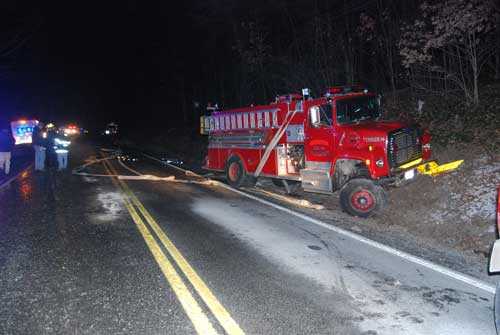
Crash site.
(Photo courtesy of fire marshal's office)
Unknown to the Tanker 14 driver, another tanker (Tanker 9) had inadvertently dropped approximately 1,500 gallons of water on the roadway while also responding to the incident. Tanker 9 had reported the inadvertent drop to their dispatcher, but Tanker 14 had not heard this communication. As Tanker 14 traveled this same roadway en route to the water source, it hit a patch of black ice that had resulted from the inadvertent water drop. The Tanker 14 driver lost control and the tanker spun around a number of times before impacting a berm on the shoulder of the roadway (see Photo 1 and Photo 2). The Tanker 14 driver was injured but was able to radio for help and crawl out of the passenger side door. The driver then saw the victim lying unresponsive in the roadway. A rescue unit from the fire scene responded to the crash along with other units and emergency medical aid was performed. The victim was taken to a local hospital where he died from his injuries.
Contributing Factors
- Failure to check the apparatus before leaving the scene (driver walk-around)
- Inadequate communications between the driver and victim
- Unintentional discharge of water onto roadway in freezing conditions
- Ice on roadway
- Fire department communication interoperability.
Key Recommendations
- Fire departments should ensure that fire fighters are properly trained to ensure that the apparatus is ready for the road before leaving the fire scene (including a driver walk-around)
- Fire departments should ensure that fire fighters are properly trained and equipped to communicate task-level functions
- Fire departments should ensure that fire department driver/operators are trained in techniques for maintaining control of their vehicle at all times
- Fire departments should ensure that fire fighters from different departments can communicate with each other via radio
- Fire departments should consider installing rear view camera(s) with monitor(s) inside the cab
- Fire apparatus manufacturers should use engineering controls (such as electronic lockouts and engineering guards) to ensure that water dump valves cannot activate unintentionally.
Introduction
On February 13, 2012, a 21-year-old male volunteer fire fighter (victim) died after falling from the tailboard of a fire department tanker. On February 13, 2012, the U.S. Fire Administration notified the National Institute for Occupational Safety and Health (NIOSH) of this incident. On February 27–March 1, 2012, a safety and occupational health specialist from the NIOSH Fire Fighter Fatality Investigation and Prevention Program in Morgantown, West Virginia (WV), traveled to Virginia (VA) to investigate this incident. Note: This crash incident, as well as the original fire incident, occurred in WV near the VA/WV state border, and departments from both states responded to both incidents. The NIOSH investigator conducted an opening meeting with the Fire Chief, county fire marshal and assistant fire marshal, and the volunteer department chief and rescue captain. The NIOSH investigator also met with the fire scene incident commander, the county deputy chief of training, and the county battalion captain. The NIOSH investigator also met with the Virginia Department of Fire Programs executive director, director of administration and branch chief of training and operations. The NIOSH investigator also met with the WV county director of emergency services and spoke with the WV state fire marshal who investigated the fire scene. The NIOSH investigator visited the incident scene and photographed the tanker involved at a secured equipment garage and the second tanker from the WV fire department. The NIOSH investigator conducted interviews with the driver of the tanker, officers and fire fighters of the involved departments who were present during the fire incident, and those personnel who responded to the apparatus crash. The NIOSH investigator reviewed the WV state police accident report, the medical examiner's report, the county fire department's standard operating guidelines, apparatus maintenance records, the driver's and the victims' training records, and incident dispatch audio tapes.
Fire Department and Equipment
The victims' department is part of a combination county-wide fire and rescue service. The county fire and rescue department is governed through a fire and rescue association that is made up of 11 departments with approximately 500 volunteers and 73 paid staff with paid staff at 10 of the 11 departments. The victim's station is a combination department that has 2 paid fire fighters during the day and is staffed by volunteers during the evening hours. It has approximately 50 volunteers with 30 active as operational fire fighters. The station houses a 1,500-gallon-per-minute pumper, a mini pumper, a 1,500-gallon tanker (tanker involved in this incident), a brush truck, 2 advanced life support ambulances, and 2 utility vehicles. The victim's station serves a population of 2,000 within an area of 100 square miles and responds to approximately 400 emergency incidents per year.
Tanker 14, the tanker involved in this incident, is a 1986 commercial chassis with a GVWR of 35,000 pounds, 2 axles, 6 wheels, 1,500-gallon tanker with a 1,000-gallon-per-minute pump, which was purchased new by the department in 1986. According to the odometer, Tanker 14 had 44,444 miles on it at the time of the incident. The tanker is diesel-powered, with a 10-speed manual transmission and air brakes with no assist braking devices. The tanker has a current Virginia state vehicle inspection sticker and has received regular maintenance performed by a commercial heavy-duty garage. None of the fire fighters interviewed reported having any issues with the braking or steering performance of Tanker 14.
Tanker 9, from the WV fire department that lost its water en route to the incident, is a 2009 commercial chassis with a GVWR of 66,000 pounds, 3 axles, 10 wheels, and a 3,000-gallon tank with a 1,250-gallon-per-minute pump. Tanker 9 has electric-over-air dump valve controls in the cab as well as two electric-over-air dump valve controls on the exterior of the truck in the rear.
Training and Experience
The driver of Tanker 14 had 10 years of fire service experience, 25 years of experience driving commercial fuel trucks, and a valid Virginia commercial class B driver's license with tank and hazardous materials endorsements. The driver had the following documented training: Commonwealth of Virginia Driver/Operator Pumper Course (modules 1–5); Emergency Vehicle Operator's Course (class 1, 2, 3); Vehicle Rescue Awareness and Operations level, Fire Fighter 1, 2, and 3; Hazardous Materials Awareness and Operations level,; Heavy Tactical Rescue Vehicle Rescue Awareness and Operations level, Rapid Intervention Team (RIT) training course, Mayday Fire Fighter Down course, Mass Casualty Incident Management course, Liquefied Petroleum Gas Emergencies course, Geriatric and Pediatric Basic Provider course, National Incident Management System IS-700a course and the state of Virginia Emergency Medical Technician (basic).
The victim had less than 1 year of service with the department. The victim had 20 hours of documented training that allowed him to participate in exterior non-IDLH fire-fighting duties and Cardio Pulmonary Resuscitation (CPR) training. In the victim's department, fire fighters and officers are issued different colored helmets that indicate rank and level of qualification. Red helmets are assigned to exterior fire fighters with non-IDLH fire-fighting duties. Yellow or black helmets are worn by fire fighters who are qualified for interior fire-fighting duties; lieutenants wear a black helmet with a white shield; and captains and chief officers wear white helmets.
The victim's department conducts in-house training and participates in joint training sessions with neighboring fire departments and the county department of fire and rescue. The county offers a 6-month fire academy, weekends and evenings, to all of the volunteer stations. The fire academy consists of classes that certify fire fighters to NFPA Fire Fighter 1 and Fire Fighter 2. In addition, the academy offers certification classes in fire apparatus driver/operator*, hazardous materials operations and vehicle extrication. The victim had planned to take the next academy class offered by the county.
*Note: Fire Fighter 1 and 2 training met the criteria for NFPA 1001 Standard for Fire Fighter Professional Qualifications1 and classes offered for driver/operator met the criteria for NFPA 1002 Standard for Fire Apparatus Driver/Operator Professional Qualifications.2
Incident Timeline
The timeline for this incident begins with the initial response of Tanker 14 (with the victim) to the fire scene and includes Tanker 14's departure from the scene and the subsequent crash.
- 0321 Hours
Victim's department was dispatched to assist West Virginia county department with a residential structural fire. Victim's department sent a pumper (Engine 14 with four fire fighters) and a tanker (Tanker 14 with victim and driver). - 0334—0358 Hours
Engine 14 arrived on scene of a working fire in a basement of a 1-story residential structure. A joint command was established with the VA and WV departments due to a radio patch communication issue between the two different departments. Engine 14 stretched a 1¾-inch hand line to attack the basement fire. Tanker 9, from the WV department, advised their dispatcher by radio that they had lost water while en route and that dispatch would need to notify the West Virginia department of highways to have a cinder truck respond. Tanker 9 arrived on scene, set up a folding dump tank behind Engine 14, and dumped their remaining water into the folding dump tank. The incident commander (IC) noted that there was a minimal amount of water in the folding tank, and the members from Tanker 9 informed the IC that they had lost half their water en route to the incident. Tanker 14 arrived on scene and staged while Tanker 9 dumped their water. Tanker 9 left the incident scene and responded to the water source to refill the tanker. Tanker 14 backed into position to dump its water into the folding tank. The victim had exited the cab and guided Tanker 14 to the folding tank from the left rear side of the tanker. The victim was not seen by anyone at this point but likely climbed up on the tailboard to access the manual dump valve and opened the valve to fill the folding tank. The driver of Tanker 14 watched the tank level indicator lights through the side mirror, and when the lights indicated that the tank was empty, the driver checked both of his mirrors, engaged the transmission and pulled away from the drop tank and responded to the fill site. The driver of Tanker 14 reported that he did not know that the victim was on the tailboard when he pulled away. One fire fighter did see the victim on the tailboard but reported that he thought the driver of Tanker 14 was going to pull away from the tank and then stop and let the victim get off the tailboard. Note: Other fire apparatus arrived on the fire scene, and three other tankers began to operate in a shuttle operation. - 0358 Hours
Virginia dispatch received and dispatched units for a motor vehicle incident. Tanker 14 driver confirmed by radio that his unit was involved. - 0359 Hours
Fire ground command heard the traffic on the radio and dispatched rescue units from the fire scene along with the Chief from the victim's department who responded to the accident scene. - 0359–0410 Hours
Tanker 14 driver exited from the passenger side door and observed the victim, unresponsive, lying in the highway behind Tanker 14. - 0410 Hours
Rescue units arrived on scene. Note: the rescue units may have arrived sooner than the recording logs show due to units arriving on scene without making notification. - 0410-0417 Hours
Rescue units began advanced life support measures to the victim and requested an air ambulance. The victim was placed in the ambulance. - 0417 Hours
Rescue unit with victim inside leaves the scene en route to the landing zone.
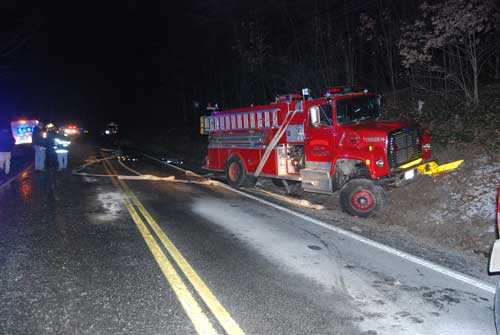
Photo 1. Crash scene. Note the black ice and dry spot on roadway.
(Photo courtesy of Fire Marshal's Office)
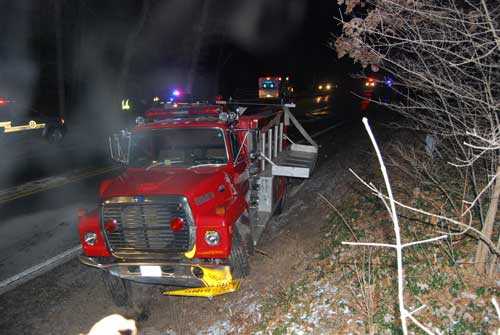
Photo 2. Tanker 14's final position against the berm. Note the reflection on the ice from the car headlights in the roadway.
(Photo courtesy of Fire Marshal’s Office)
Personal Protective Equipment
The victim was wearing turnout gear including coat, pants, and helmet (compliant with NFPA 1971 2006 edition). Fire-fighting gloves were found inside the coat pockets. It is not known if the victim was wearing any utility gloves. The glove holder on the turnout coat was empty, but no one could remember removing any gloves or hood during the emergency medical care
Road and Weather Conditions
Tanker 14 was traveling on a two-lane asphalt state highway with a posted speed limit of 55 mph. The incident occurred after a slight left turn and 3% downgrade in the roadway that was covered with ice in both lanes for approximately 150 feet. The roadways in the area were reported as dry by other emergency personnel and police. At the time of the incident (approximately 0400 hours), the weather was scattered clouds with an approximate temperature of 28°F and a wind chill of 17°F. The relative humidity was 59% and the wind was from the west at 13.8 mph, with gusts of 20.7 mph.3 The icy road condition where the crash occurred was a contributing factor in this incident.
Investigation
On February 13, 2012, a 21-year-old male volunteer fire fighter (victim) died after falling from the tailboard of a fire department tanker (Tanker 14). The victim responded to the station after his department was dispatched to a mutual aid residential structure fire in neighboring West Virginia. Engine 14, from the victim's department, had already left the station en route to the fire, and the victim waited at the station for a tanker driver to arrive. The tanker driver arrived and the two fire fighters left for the fire scene in Tanker 14.
Engine 14 arrived at the scene of a working fire in a basement of a one-story residential structure. A joint command was established with the Virginia and West Virginia departments due to a radio patch issue that prevented direct radio communication between the two departments. Engine 14 stretched a 1¾-inch hand line to attack the fire in the basement.
Note: The NIOSH investigator was not able to interview the driver or crew member of Tanker 9. The following information regarding Tanker 9 is taken from a written statement given to the West Virginia Fire Marshal. Tanker 9 (from the West Virginia department) responded from their station, and while en route to the fire scene, noticed a buzzer sounding on the dash. The driver looked in the mirrors and everything seemed normal, so he continued their response. The driver then noticed his left side scene lights were activated and was unsuccessful in attempts to turn them off. The driver then noticed in his left mirror, water flowing from the driver's side dump chute. The driver then pulled off the road and manipulated the dump valve switches and successfully closed the dump valve and turned off the scene lights and then continued to the scene.
An assistant chief from the West Virginia department was responding in his private vehicle when he noticed Tanker 9 dumping water in the roadway. According to his statement, he tried to communicate with Tanker 9 on three separate radio frequencies and was unsuccessful. He passed Tanker 9 when they pulled over to fix the dump valve and continued his response to the fire scene. Tanker 9 arrived on scene, set up a folding dump tank behind Engine 14, and dumped their water into the folding dump tank. The incident commander (IC) noted the minimal amount of water in the folding tank, and the members from Tanker 9 informed the IC that they had lost half their water en route to the incident.
Tanker 14 arrived on scene and staged while Tanker 9 was dumping their water into the folding dump tank. Tanker 9 left the incident scene and responded to the water source to refill their tank. While driving to the fill site, Tanker 9 drove through the area of the roadway where they had previously dropped the water and noticed the area to be slick. Tanker 9 did not mark the area with road flares, but did radio his dispatcher that they had dumped water on the roadway and would need the highway department to respond.
During this same time period Tanker 14 was positioning his truck to dump water into the folding tank. The driver of Tanker 14 told the victim to back him up to the folding tank. The victim exited the cab and guided the driver of Tanker 14 from the left rear side of the tanker. The driver of Tanker 14 stayed in the driver's seat and watched the water gauge indicator lights on the pump panel through his side mirror. The driver saw the victim get up on the tailboard, and then the victim disappeared from his view. The victim was not seen by anyone at this point but likely climbed up on the tailboard, to access the manual dump valve, and opened the valve to fill the folding tank (see Photo 3). The driver of Tanker 14 watched the tank level indicators on Tanker 14 through the side mirror, and when the empty light flashed, he checked both mirrors, released the brake, engaged the transmission, revved the engine a couple of times, and pulled away from the scene. The driver of Tanker 14 reported that he did not know that the victim was on the tailboard when he pulled away and assumed that the victim was going to stay at the dump site. One fire fighter did see the victim on the tailboard, and stated that the victim was facing away from the truck with his coat unbuttoned and possibly fumbling with the buttons on his coat, but reported that he thought that the driver of Tanker 14 was going to pull away from the tank and then stop and let the victim get off the tailboard. This fire fighter turned away from the tanker and went back to work on the fire scene. Other fire apparatus arrived on the fire scene and three other tankers began to operate in a shuttle operation. Tanker 14 then left the scene and responded to the fill source with warning lights activated.
The Tanker 14 driver reported that he had not heard the communication about the icy road condition over his frequency and was unaware of the ice on the roadway. The driver of Tanker 14 reported during interviews that he was driving the truck at approximately 45 miles per hour and, when he came around a curve in the roadway, he lost control of the truck on a large sheet of black ice. The tanker spun around a number of times before impacting a berm on the left side of the road. The driver used the truck radio to tell the Virginia dispatcher that he had been involved in an accident and crawled out the passenger door. After he got out of the tanker he saw the victim lying unresponsive in the middle of the highway (see Photo 4). The victim was likely ejected from the tailboard while the truck was spinning. Hose and equipment from Tanker 14 were also ejected from the rear hose bed and the cross lay hose compartments. The folding tank was also ejected from the holding brackets on the left side (see Photo 5).
Rescue units from the fire scene responded along with other units dispatched for the crash. Emergency medical care was performed, and the victim (who still had a pulse) was placed in an ambulance and initially transported to a landing zone for an air ambulance. During transport to the landing zone the victim lost his pulse and the ambulance was diverted from the landing zone to the hospital per Medevac protocols where he was pronounced dead.
After the incident, Tanker 9 returned to quarters, and the department immediately placed Tanker 9 out of service and contacted the manufacturer to help identify the problem. The apparatus manufacturer sent a representative and the tanker was examined. No issues could be found other than a delay in the electric-over-air valve activation that occurred after engaging the switch to deploy the water chute. The department asked the manufacturer to install an interlock that would prevent activation of the cab water control switches until the maxi brake is engaged. The manufacturer stated in a phone interview that the exterior rear control switches are not active until the maxi brake is engaged, but the interior switches are active.
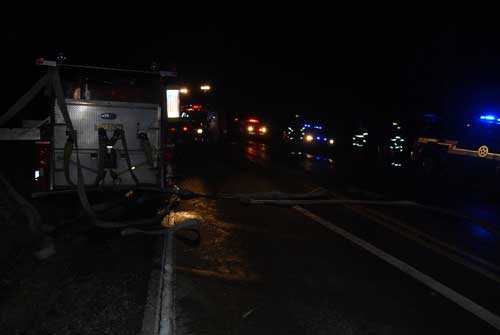
Photo 3. Crash scene of Tanker 14's tailboard after victim was ejected.
(Photo courtesy of Fire Marshal's Office)
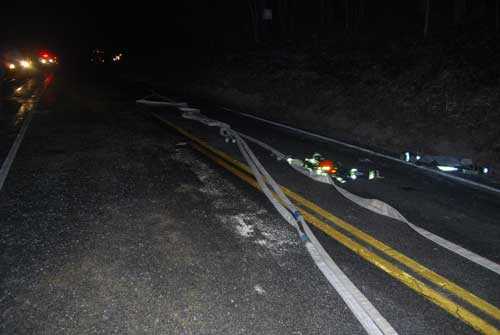
Photo 4. Victim's location (indicated by turnout gear) after being ejected from tailboard.
(Photo courtesy of Fire Marshal's Office)
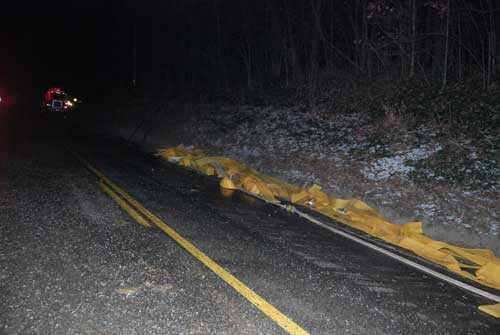
Photo 5. Hose and equipment ejected from Tanker 14.
(Photo courtesy of Fire Marshal's Office)
Contributing Factors
Occupational injuries and fatalities are often the result of one or more contributing factors or key events in a larger sequence of events that ultimately result in the injury or fatality. NIOSH investigators identified the following items as key contributing factors in this incident that led to this fatality:
- Failure to check the apparatus before leaving the scene (driver walk-around)
- Inadequate communications between the driver and victim
- Unintentional discharge of water onto roadway in freezing conditions
- Ice on roadway
- Fire department communication interoperability.
Cause of Death
According to the medical examiner's certificate, the cause of death was blunt trauma to the chest, abdomen, and extremities.
Recommendations
Recommendation #1: Fire departments should ensure that fire fighters are properly trained to check the apparatus before leaving the scene (driver walk-around).
Discussion: The driver of any fire apparatus is ultimately responsible for the safety of everyone on board the truck and crew accountability is everyone's responsibility. Any piece of fire apparatus must be checked for loose equipment and open compartment doors and to ensure that all personnel are seated in riding positions and seat belted before the apparatus is moved. Whether the truck is responding to an emergency or going on a non-emergency utility run, the driver must ensure the apparatus is ready to be on the road and if necessary, by walking around the truck before it moves. NFPA 1500 Standard on Fire Department Occupational Safety and Health Program, Chapter 6.2.4, states, "Drivers of fire apparatus shall be directly responsible for the safe and prudent operation of the vehicles under all conditions." NFPA 1500, Chapter 6.3.1, states, "Standing or riding on tail steps, side steps, running boards, or in any other exposed position shall be specifically prohibited."4, 5 The International Association of Fire Chiefs provides a Guide to IAFC Model Policies and Procedures for Emergency Vehicle Safety.6 One of the areas that the Guide addresses is maneuvering at an incident scene and checking for unsecured personnel. While maneuvering at an incident scene, drivers shall exercise extreme caution; other drivers and pedestrians may be distracted or preoccupied by events and a variety of hazards may be encountered. Before moving an emergency vehicle in any location, the driver shall ensure that all occupants are seated and properly secured in approved riding positions. The driver shall ensure and the officer shall verify that no one is in the process of mounting, dismounting, or standing on top of or on the outside of the vehicle. Under no circumstance shall members be allowed to ride on the outside of a moving apparatus, including the tailboard, roof, aerial platform or bucket, or a top-mounted pump panel.6
In this incident, the driver was operating according to a rural water shuttle training program that emphasized speed, with the driver remaining in the cab during the discharge of water. The training guide also emphasized that an adequate number of personnel be available to perform the job safely and effectively and that personnel are experienced in their assigned task. The victim was not experienced in his assigned task. Tanker drivers involved in a rural water supply operation must ensure that his/her truck is ready for the road when they pull away to go to the fill site. This can be accomplished by getting out of the truck or by communications from someone outside of the truck (water supply officer) who can insure that it is safe to proceed. Insuring crew accountability is everyone's responsibility and can be accomplished through positive communications with all crew members. The driver should not leave until everyone on the crew is accounted for. Performing a walk around could have been accomplished while the dump valve was filling the tank. The fire department involved in this incident has since instituted a policy that the driver of any apparatus must complete a walk around of the truck before moving the apparatus.
Recommendation #2: Fire departments should ensure that fire fighters are properly trained and equipped to communicate task-level functions.
Discussion: Fire fighters must be properly trained to communicate task-level functions and never rely on intended or implied communications. This is especially important when inexperienced members or crews who have not worked together are given fire ground tasks. Inexperienced members or crews who do not work together often may not know what is expected of them or, just as important, how a task is supposed to be accomplished. Just as strategic- and tactical-level commands must be understood by all fire fighters on an incident scene, task-level commands and communications must be positively communicated and fire fighters should not rely on past precedence on how a particular task should be accomplished. NFPA 1500 Standard on Fire Department Occupational Safety and Health Program, Chapter 8.5.3, states, "When inexperienced members are working at an incident, direct supervision shall be provided by more experienced officers or members."4 These task level communications can be reinforced through mentoring programs that allow apprentice or new fire fighters to work with more experienced members when learning or performing basic fire-fighting skills. The mentoring programs should include commonly used person to person communication techniques such as hand signals and other positive communication techniques. The communication of task-level and tactical-level functions can also be reinforced through regular training for mutual aid companies. Communication skills involving rural water supply, tanker shuttles and safe practices can be enhanced through regular training with different mutual aid companies.
In this incident, the driver assumed the victim was going to stay at the dump site where the folding tank was and did not know that the victim was still on the tailboard of the tanker when he pulled away. The victim was likely still on the tailboard due to its proximity to the full folding tank of water. The temperature was extremely cold the night of the incident and the victim was likely not able to stay clear of the water in the tank without being on the tailboard. The victim was reportedly well aware of the department's long standing regulation of not riding the tailboard and was likely stuck on the tailboard unable to dismount when the tanker pulled away. The victim's fire-fighting gloves were found by the NIOSH investigator folded in his fire coat pockets. The tailboard grab bar, being exposed metal, would have been very cold and difficult to hold on to. The victim had less than a year of experience and should have been given specific instructions with positive communications that would have instructed him to complete the task and return to the cab or stay on the scene. The victim did not have a portable radio and the tanker did not have a buzzer on the tailboard that would have alerted the driver.
Recommendation #3: Fire departments should ensure that fire department driver/operators are trained in techniques for maintaining control of their vehicle at all times.
Discussion: Fire apparatus driver/operators are responsible for safely transporting fire fighters, apparatus, and equipment to and from the scene of an emergency or other calls for service. Responding to and returning from emergencies is second only to heart attacks in the cause of death of fire fighters.7 Under all circumstances, the fire apparatus driver/operator must exercise care for the safety of others and must maintain complete control of the vehicle.7 Avoiding conditions that lead to skidding is as important as knowing how to correct skids once they occur. The most common causes of skids include:
- Driving too fast for conditions
- Failing to properly appreciate weight shifts of heavy apparatus
- Failing to anticipate obstacles (these range from other vehicles to animals)
- Improper use of auxiliary braking devices
- Improper maintenance of tire air pressure and adequate tread depth
A flat, dry, paved road provides the optimal stopping surface. The ability of a driver/operator to stop the apparatus is negatively affected by steep, wet, snowy, icy, or unpaved roads. Driver/operators must compensate for these conditions by reducing their speeds by an appropriate amount to match the conditions.7
In this incident, the driver of Tanker 14 reported his speed as approximately 45 mph and the road conditions were dry. The driver reported that, after coming around the turn and hitting the sheet of ice, the rear end of the tanker started to slide to the right; he attempted to correct by steering in a corrective fashion, but the truck did not respond and the tanker began a number of 360-degree spins before impacting the berm on the left side of the road. West Virginia state police reported speed and ice on the roadway as contributing factors in the crash.
Recommendation #4: Fire departments should ensure that fire fighters from different departments can communicate with each other.
Discussion: The tanker that lost its water en route to the fire incident communicated with the West Virginia dispatcher that they had lost a significant amount of water, realized the icing conditions, and called for a state highway cinder truck to respond. An assistant chief from the same department was behind Tanker 9 and saw the truck dumping water on the highway; he tried unsuccessfully on three radio channels to contact Tanker 9. The state highway truck responded quickly to the reported area but arrived after Tanker 14 had crashed. The driver of Tanker 14 never heard Tanker 9's radio transmission that it had dropped the water; other Virginia units reported that they did not hear the communications. The fire fighter who saw the victim on the tailboard of the tanker did not realize that the truck was pulling away with the victim apparently stuck on the tailboard. This fire fighter would not have been able to communicate with Tanker 14 on his portable radio as he was on the West Virginia frequency. The incident commander on the fire scene reported during interviews that a radio patch system was not working the night of the fire and that communications were significantly hampered; this system allows the West Virginia units operating on an 800 frequency to talk with the Virginia units operating on a VHF frequency. The mutual aid communications network reportedly suffered a breakdown the evening of the incident and units were having considerable difficulty talking with each other. If the mutual aid communications system had worked properly, all responding apparatus could have known about the water being dropped on the highway and could have adjusted their response routes or response speed to allow for the hazardous road conditions. Tanker 9 could have received the communications from their assistant chief that they were dropping water en route to the incident, possibly stopping sooner and shutting off the water and possibly marking the hazard with road flares. Fire departments that frequently respond to mutual aid incidents should consider the installation of separate radio hardware for mutual aid response that would allow communications in the event of a radio patch failure.
Since this incident, the West Virginia emergency communications center has fixed the patch system to ensure better communications between the mutual aid departments and has proposed a weekly test with the Virginia departments to verify that the system is working properly.
Recommendation #5: Fire departments should consider installing rear view camera(s) with monitor(s) inside the cab.
Discussion: Many manufacturers offer rear-mounted cameras, which allow the driver of fire apparatus to view the conditions at the rear of the truck from the cab. This is especially important in tanker operations when the driver could be expected to remain in the cab while filling a folding dump tank. Departments may also consider a rear mounted hyperbolic mirror as a less costly alternative to cameras on older tankers.
In this incident, Tanker 9 had a rear-mounted camera (see Photo 6) but Tanker 14 did not. If Tanker 14 had a rear-mounted camera or a rear mounted hyperbolic mirror, the driver may have been able to see the victim still on the tailboard, and when the victim did not dismount from the tailboard, the driver could have communicated with him before he left for the fill site.
Recommendation #6: Fire apparatus manufacturers should ensure that water dump valves cannot activate unintentionally through engineering controls such as electronic lockouts on remote valves that only allow activation if the main brake system is engaged and switch guards over control switches in the cab.
Discussion: Tanker 9 had experienced a malfunction 1 year prior to this incident. A control valve in the rear of the truck malfunctioned after the truck's engine was started, and water coming from the left rear discharge outlet flooded the floor of the fire station apparatus bay. The malfunction was traced back to a control box that was improperly operating due to moisture on the exterior left rear side of the truck (see Photo 7). The manufacturer replaced the control switches with sealed switches, and no other issues or reoccurrences were reported.
On the morning of this incident, Tanker 9 was responding to the fire incident and the driver noticed water flowing from the left rear discharge while en route. Tanker 9 contacted their dispatcher by radio and requested a highway truck respond to treat the roadway. Tanker 9 arrived on the scene, discharged their water into the folding dump tank, and told command that they had lost water en route to the incident. After Tanker 9 emptied their tank, they left the fire scene and responded back to the fill site. They were responding back to the fire scene when they came upon the Tanker 14 crash and stopped and assisted. After the incident, Tanker 9 returned to quarters, and the department immediately placed Tanker 9 out of service.
The department contacted the manufacturer to help identify the problem. The apparatus manufacturer sent a representative to examine the tanker. No issues could be found other than a delay in the electric-over-air valve activation that occurred after engaging the switch that deploys the water chute. The department asked the manufacturer for an interlock to be installed that would not allow the cab water control switches to be active unless the maxi brake is engaged. The manufacturer stated in a phone interview that the exterior rear control switches are not active until the maxi brake is engaged, but the interior switches are active. Apparatus manufacturers should consider an interlock that will not energize any of the electric-over-air control switches unless the apparatus maxi brake is applied. Fire apparatus manufacturers should also consider placing a switch guard over the vital control switches inside of the cab.
In this incident, it was noted that the tanker's controls for scene lighting and the rear discharge dump valves are identical rocker-style switches, positioned inline and close to each other on the drivers' cab control console (see Photo 8). Although the cause of the water drop could not be determined, a control switch could easily be accidentally activated if a member of the crew was attempting to activate or deactivate scene lights, or something similar, close to the water dump control switches. The use of switch guards, or covered switches, to control certain critical functions, such as water discharge, could guard against their unintended activation, especially by personnel in a dark cab responding to a call. The use of dissimilar-shaped switch buttons/levers may also provide protection against inadvertent activation, by providing the operator with tactile information to assist in identifying each switch.
Recommendation #7: Fire departments should ensure that fire apparatus drivers are properly trained to recognize, communicate and mark hazardous road conditions whenever possible.
Discussion: Tanker 9 was responding to the fire incident and the driver noticed water flowing from the left rear discharge while en route. Tanker 9 contacted their dispatcher by radio and requested a highway truck respond to treat the roadway. Tanker 9 arrived on the fire scene, discharged their water into the folding dump tank, and told command that they had lost water en route to the incident. After Tanker 9 emptied their tank, they left the fire scene and responded back to the fill site. Tanker 9 responded back through the area of roadway where they had unintentionally dropped a large amount of tank water on the roadway and although they had notified their dispatcher of the need for a highways truck to respond, they did not stop and mark the dangerous area. Fire apparatus drivers should be trained to stop whenever possible and mark hazardous road conditions that might endanger other responding apparatus or the motoring public. There could be situations when fire apparatus drivers might not be able to stop and mark all hazardous roadway conditions such as during or after severe storms, natural disasters etc., but they can communicate the roadway conditions to their dispatcher or the incident commander so that highway resources can be notified. Fire fighters can mark the hazardous area with roadway flares or other signaling devices and/or using their own emergency lights to warn oncoming traffic until relieved by law enforcement or highway crews.
In this incident the weather was extremely cold but the roads were dry. Other fire apparatus drivers might not have expected to find such a large area of the roadway covered with ice.
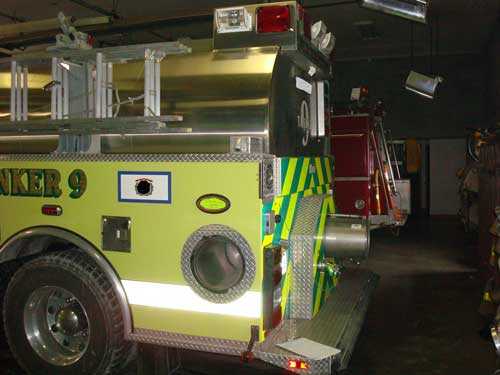
Photo 6. Tanker 9 side and rear discharge chutes.
(NIOSH photo)
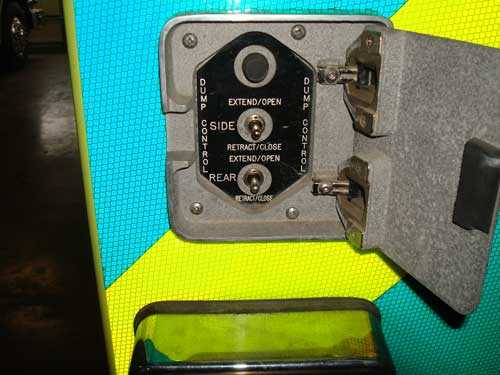
Photo 7. Tanker 9 left rear discharge control switch that had been repaired in April 2011.
(NIOSH photo)
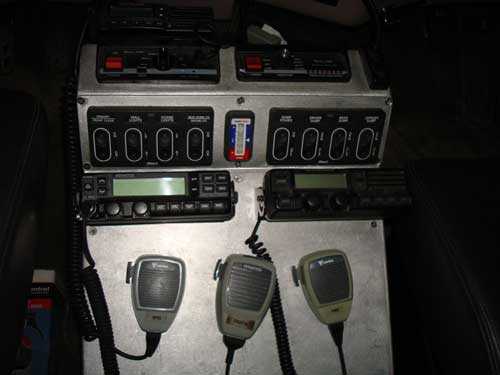
Photo 8. Tanker 9 control console. Note the identical control switches for scene lights and discharge dump valves.
(NIOSH photo)
References
- NFPA [2008]. NFPA 1001 Standard for firefighter professional qualifications. 2008 ed. Quincy, MA: National Fire Protection Association.
- NFPA [2009]. NFPA 1002 Standard for fire apparatus driver/operator professional qualifications. 2009 ed. Quincy, MA: National Fire Protection Association.
- Weather Underground [2012]. Weather history for Gore VA, February 13, 2012 [http://www.wunderground.com/history/airport/KOKV/2012/2/13/DailyHistory.html?req_city=NA&req_state=NA&req_statename=NA]. Date Accessed: March 7, 2012.
- NFPA [2007]. NFPA 1500 Standard on fire department occupational safety and health program. Quincy, MA: National Fire Protection Association.
- NFPA [2007]. NFPA 1451 Standard for a fire service vehicle operations training program. 2007 ed. Quincy, MA: National Fire Protection Association.
- International Association of Fire Chiefs [2007]. Guide to IAFC model policies and procedures for emergency vehicle safety [http://www.iafc.org/files/1SAFEhealthSHS/VehclSafety_IAFCpolAndProceds.pdf]. Date accessed: April 2012. (Link updated 10/28/2013)
- IFSTA [2006]. Pumping apparatus driver/operator handbook. 2nd ed. Stillwater, OK: International Fire Service Training Association, Fire Protection Publications.
Investigator Information
This incident was investigated by Stephen Miles, Occupational Health Specialist with the Fire Fighter Fatality Investigation and Prevention Program, Surveillance and Field Investigations Branch, Division of Safety Research, NIOSH, located in Morgantown, WV. An expert technical review was provided by John Tippett, Deputy Chief of Operations for the City of Charleston Fire Department. He is a 37-year veteran of the fire service. Chief Tippett spent 34 years with the Montgomery County (MD) Fire and Rescue Service, retiring as the department's safety battalion chief in 2009. He has been involved in a number of fire fighter health and safety initiatives over the last decade including introducing crew resource management to the fire service and working closely with the IAFC's National Fire Fighter Near-Miss Reporting System. A technical review was also provided by the National Fire Protection Association, Public Fire Protection Division.
Additional Information
- Winter driving tips for fire fighters and paramedics/EMTs [http://www.fireengineering.com/articles/2011/12/winter-driving-tips.html].
- United States Fire Administration (2004) Emergency Vehicle Safety Initiative/FA-272, Emmitsburg, MD [http://www.usfa.fema.gov/downloads/pdf/publications/fa-272.pdf ]
- United States Fire Administration (1999) Guide to Developing Effective Standard Operating Procedures for Fire and EMS Departments/FA-197, Emmitsburg, MD [http://www.usfa.fema.gov/downloads/pdf/publications/fa-197.pdf ]
- United States Fire Administration & The National Volunteer Fire Council (2006) Emergency Vehicle Safe Operations for Volunteer & Small Combination Emergency Services Organizations, Washington, DC [http://www.nvfc.org/files/documents/EVSO_2009.pdf]
- United States Fire Administration & The International Association of Fire Fighters (2006) Improving Apparatus Response and Roadway Operations Safety in the Career Fire Service, Washington, DC [http://www.iaff.org/hs/evsp/2010%20Instructor%20Guide.pdf ]
- United States Fire Administration, Safe Operation of Fire Tankers, Emmitsburg, MD [http://www.usfa.fema.gov/downloads/pdf/publications/fa-248.pdf]
- The National Fire Fighter Near-Miss Reporting System [www.firefighternearmiss.com]
Disclaimer
Mention of any company or product does not constitute endorsement by the National Institute for Occupational Safety and Health (NIOSH). In addition, citations to Web sites external to NIOSH do not constitute NIOSH endorsement of the sponsoring organizations or their programs or products. Furthermore, NIOSH is not responsible for the content of these Web sites.
The National Institute for Occupational Safety and Health (NIOSH), an institute within the Centers for Disease Control and Prevention (CDC), is the federal agency responsible for conducting research and making recommendations for the prevention of work-related injury and illness. In 1998, Congress appropriated funds to NIOSH to conduct a fire fighter initiative that resulted in the NIOSH "Fire Fighter Fatality Investigation and Prevention Program" which examines line-of-duty-deaths or on duty deaths of fire fighters to assist fire departments, fire fighters, the fire service and others to prevent similar fire fighter deaths in the future. The agency does not enforce compliance with State or Federal occupational safety and health standards and does not determine fault or assign blame. Participation of fire departments and individuals in NIOSH investigations is voluntary. Under its program, NIOSH investigators interview persons with knowledge of the incident who agree to be interviewed and review available records to develop a description of the conditions and circumstances leading to the death(s). Interviewees are not asked to sign sworn statements and interviews are not recorded. The agency's reports do not name the victim, the fire department or those interviewed. The NIOSH report's summary of the conditions and circumstances surrounding the fatality is intended to provide context to the agency's recommendations and is not intended to be definitive for purposes of determining any claim.
- Page last reviewed: November 18, 2015
- Page last updated: October 15, 2014
- Content source:
- National Institute for Occupational Safety and Health Division of Safety Research


 ShareCompartir
ShareCompartir